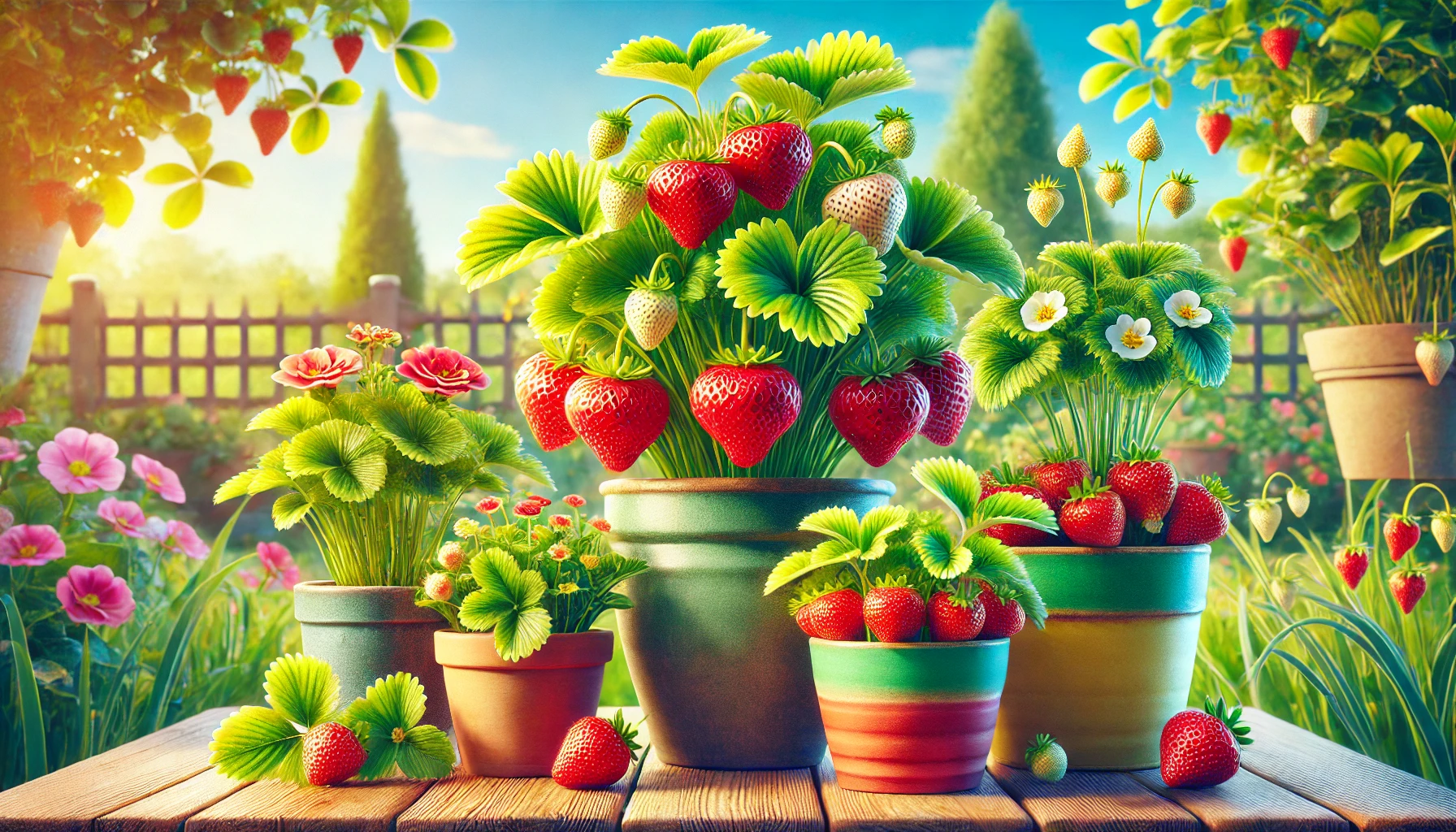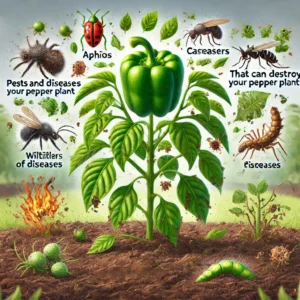Strawberries are a popular fruit known for their bright red color, juicy texture, and sweet taste. They are rich in vitamins, antioxidants, and fiber, making them a healthy choice for any diet. Growing strawberries in pots is a convenient option for those with limited garden space, allowing you to enjoy fresh strawberries right from your balcony or patio. This guide will provide detailed steps on how to grow strawberry plants in a pot, from selecting seeds to harvesting your crop.
Ideal Pot Size for Strawberries
For growing strawberries, a pot with a diameter of at least 12 inches (30 cm) and a depth of at least 8 inches (20 cm) is ideal. This size ensures enough space for root development and proper drainage.
Perfect Weather Conditions for Strawberries
| Weather Condition | Ideal Range |
|---|---|
| Temperature | 60-80°F (15-27°C) |
| Sunlight | Full sun, at least 6-8 hours daily |
| Soil pH | 5.5-6.8 |
| Humidity | Moderate |
| Rainfall | 1-1.5 inches per week |
Choosing the Right Seeds
From the Shop:
- Variety: Choose a variety suitable for container growing, such as ‘Alpine’, ‘Day-neutral’, or ‘Ever-bearing’ strawberries.
- Quality: Buy seeds from reputable suppliers to ensure high germination rates and healthy plants.
- Organic: Opt for organic seeds to avoid synthetic chemicals.
Collecting and Preserving Seeds:
- From Fresh Strawberries: Select ripe, healthy strawberries. Mash the fruit and rinse the pulp away from the seeds using water. Dry the seeds on a paper towel for a few days before storing them.
- Preservation: Store seeds in an airtight container in a cool, dry place. Label the container with the date and variety.
Growing Strawberry Seedlings from Seed
- Preparation:
- Fill a seed tray with a high-quality seed-starting mix. Lightly moisten the soil.
- Scatter strawberry seeds on the soil surface. Press them lightly into the soil without covering them completely.
2. Germination:
- Cover the seed tray with a clear plastic lid or plastic wrap to create a humid environment.
- Place the tray in a bright location, but out of direct sunlight. Maintain a temperature of 65-75°F (18-24°C).
- Seeds typically take 2-3 weeks to germinate.
3. Transplanting Seedlings:
- Once seedlings have 2-3 true leaves, transplant them into individual pots.
- Handle seedlings carefully to avoid damaging the roots.
Nutrition Requirements for Strawberry Plants
| Nutrient | Importance | Frequency of Application |
|---|---|---|
| Nitrogen (N) | Promotes healthy leaf and stem growth | Every 4-6 weeks |
| Phosphorus (P) | Supports root development and flowering | Every 4-6 weeks |
| Potassium (K) | Enhances fruit quality and disease resistance | Every 4-6 weeks |
| Calcium (Ca) | Strengthens cell walls, preventing diseases | As needed |
| Magnesium (Mg) | Essential for photosynthesis | As needed |
Soil Mix for Strawberry Plants
| Ingredient | Amount | Alternative | Soil Ratio |
|---|---|---|---|
| Organic Compost | 1 part | Well-rotted manure | 30% |
| Peat Moss | 1 part | Coconut coir | 30% |
| Perlite | 1 part | Vermiculite | 30% |
| Garden Soil | 1/2 part | Commercial potting mix | 10% |
Making the Soil Mix:
- Combine 30% organic compost, 30% peat moss, 30% perlite, and 10% garden soil in a large container.
- Mix thoroughly to ensure even distribution.
- Moisten the soil mix lightly before using it to fill your pots.
Special Instructions for Pot Drainage System
- Ensure your pot has drainage holes at the bottom to prevent waterlogging.
- Place a layer of gravel or small stones at the bottom of the pot to improve drainage.
- Use a saucer under the pot to catch excess water, but empty it regularly to avoid standing water.
Transferring Seedlings to the Pot
- Timing: Transplant seedlings after the last frost date in your area when they have at least 4-6 true leaves.
2. Preparation:
- Fill the pot with the prepared soil mix.
- Water the soil to settle it before planting.
3. Transplanting:
- Dig a small hole in the soil mix large enough to accommodate the root system of each seedling.
- Carefully remove seedlings from their pots, keeping the root ball intact.
- Place seedlings in the holes, ensuring the crown (where the stem meets the roots) is at soil level.
- Fill in around the roots with soil, firming gently.
- Water thoroughly after transplanting.
Stages of Growth and Care in Pots
1. Early Growth:
- Watering: Keep the soil consistently moist but not waterlogged. Water early in the day to allow leaves to dry.
- Fertilizing: Apply a balanced, all-purpose fertilizer every 4-6 weeks.
- Pruning: Remove any runners (long stems that produce new plants) to focus energy on fruit production.
2. Flowering:
- Watering: Increase watering slightly to support fruit development. Ensure even moisture.
- Fertilizing: Use a high-potassium fertilizer to promote flowering and fruiting.
- Pruning: Continue to remove runners and any diseased or damaged leaves.
3. Fruiting:
- Watering: Maintain consistent moisture levels, ensuring the soil does not dry out.
- Fertilizing: Apply a light feeding of balanced fertilizer if needed.
- Pruning: Remove excess foliage that shades the fruits, improving air circulation and reducing disease risk.
Special Instructions for Growing in Pots
- Location: Place pots in a location that receives full sun for at least 6-8 hours daily.
- Rotation: Rotate the pots periodically to ensure even sunlight exposure on all sides of the plants.
- Protection: Protect plants from strong winds and extreme temperatures by moving pots to sheltered areas when necessary.
- Pest Control: Regularly inspect plants for pests and treat with organic insecticidal soap if needed.
Harvesting and Preserving Strawberries
- Harvesting:
- Pick strawberries when they are fully red and slightly soft to the touch.
- Harvest in the morning when the berries are cool and firm.
- Gently twist the berry from the stem to avoid damaging the plant.
2. Preserving:
- Refrigeration: Store fresh strawberries in the refrigerator for up to a week.
- Freezing: Wash and hull strawberries, then spread them on a baking sheet to freeze individually before transferring to a freezer bag.
- Jam: Preserve strawberries by making homemade jam, following a reliable recipe.
By following these steps, you can successfully grow strawberries in pots and enjoy a bountiful harvest of fresh, homegrown strawberries. Whether you choose to refrigerate, freeze, or make jam, you’ll have the satisfaction of savoring strawberries you’ve grown yourself.



